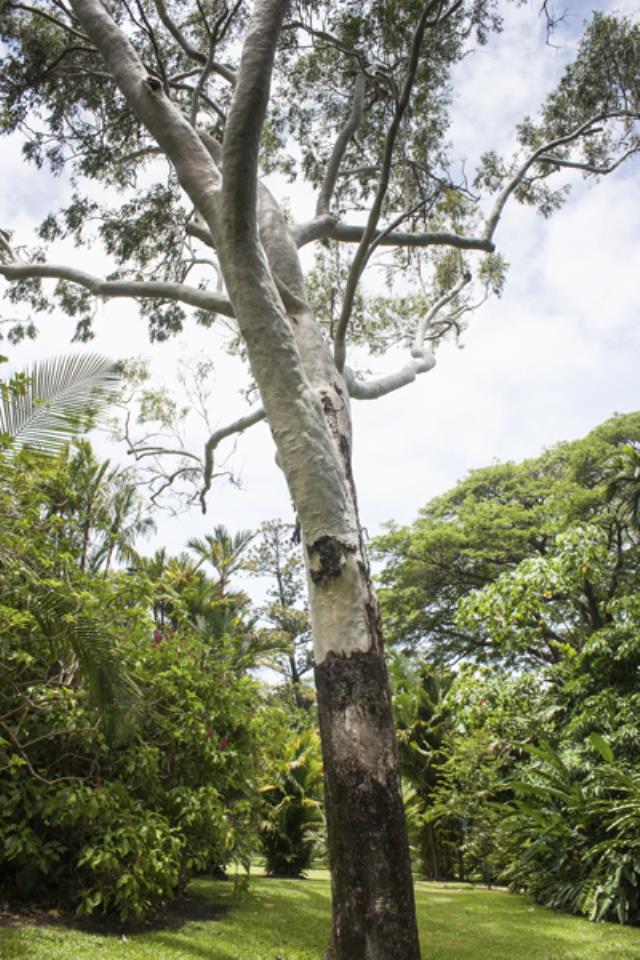By Beatrice Hawkins
‘Trees Again’.
As readers you will realise I have spent some time out in the west of the state and that I have a love of that area and the trees that grow there, particularly natives.
I had seen some beautiful specimens growing in a few places, especially around Dirranbandi and St George, but had been unable to find a name for a particular tree that intrigued me. On a trip to Goondiwindi recently I saw them again in one area and also saw many beautiful brigalows, weeping myalls and belahs and, of course, grey box with their distinctive shiny green leaves that seem to sparkle in the sun. I just love the diversity of colour and shapes evident among our native trees.
The tree whose name I have been seeking is a carbeen, otherwise known as Morton Bay Ash or black butt and botanically as Corymbia tessellaris.
It is a spectacular tree to about 30 metres tall forming a lignotuber, with black tessellated bark from 1 to 4 metres up the trunk. This bark stops abruptly and the spectacular cream or grey smooth barked trunk continues to a lofty, leafy canopy.
I had to investigate further the meaning of lignotuber and discovered that it is a large, woody outgrowth around the base of the tree trunk. These are also sometimes known as root burls. These growths contain a mass of buds, from which new stems may sprout, and food reserves that can support growth for a period.
They can be either above or below the ground. They are most common on trees that are in areas prone to fire and drought. Nature’s way of protecting the trees in tough times and ensuring they survive.
The term “lignotuber” was coined by Australian botanist Leslie R. Kerr in 1924.
Among the many Australian trees possessing lignotubers is the Western Australian Jarrah and they can be up to 10 feet wide and 3 feet deep! Many other eucalyptus, varieties of mallee and banksias also have lignotubers.
The beautiful Carbeen tree grows in an area from Narrabri north through Charleville and right up to Cape York Peninsula. Locally I have seen them out in the Goomburra area.
It is, in fact, the most northerly growing eucalypt with a specimen growing right up near the tip of the cape. I have read of them being described as an ideal street tree. Given the height to which they can grow I have my doubts on that, especially if they were anywhere near overhead power lines.
The largest lignotuber in Australia is probably a Red Bloodwood tree known as “Old Bottle Butt” growing near Wauchope in N.S.W. The lignotuber on this tree is about 2.5 metres high and 16.3 metres in circumference at chest height.
They are not unique to Australian trees as the huge Californian redwoods also have lignotubers as do trees in many other areas of the globe.
In 1977, during a wild storm in California, a lignotuber was washed into Blue Lagoon near Eureka. It
was about 12.5 metres in diameter, approximately half as high and was estimated to weigh an amazing 476.3 tonnes!
Don’t forget the autumn flower show in St Mary’s Hall on Wednesday 6 and Thursday 7 March. The show will be open to the public from noon on Wednesday following the completion of judging and from 9 to 4 on Thursday.
Assorted fresh sandwiches for a light lunch will be available on both days along with delicious sweet treats, Devonshire teas and, new this time, cappuccino and flat white coffees made by an expert barista!
If you have nothing in your garden to enter come and see what the dedicated gardeners of our area can produce in hard times.
(SUBHEAD)
A garden update…
The hot weather has decimated my vegetable garden and very few watermelons were enjoyed!
Rockmelons were a different story with lots being picked, enjoyed and shared with friends. The flavour of fresh melons straight from the garden is really delightful. They are still thriving and setting fruit so obviously this garden is in a position that suits them admirably.
The cucumbers have been spectacular and many have been shared around. Large quantities of cucumber and pineapple pickles made and shared also. Something different and delightful with cold meats or as a dip.
The prickly cucumbers that I experimented with are growing well but haven’t set much fruit as yet.
The extreme weather even ruined my climbing beans and the only tomatoes to continue producing are the tiny yellow low acid ones. I do have bok choy and wombok coming on well however and the passionfruit vine is flourishing.
*This is an old article that has been digitised so our readers have access to our full catalogue.







